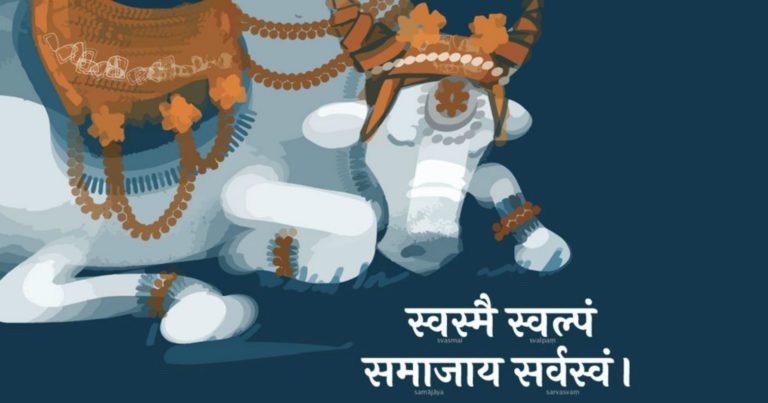Celebrating ‘Sanskrit Diwas’ gives us an opportunity to ponder again promote Sanskrit not only as a language but also a language of ancient text from India which is still not explored to the fullest to establish India as a Vishva Guru.
Not many know that Sanskrit Diwas is celebrated in India on Shrawani Purnima every year, i.e., the day of the festival of Rakshabandhan. It is one among two special days for any languages dedicated by the government of India. In ‘Manu Smriti’ this auspicious day marks the beginning of ‘Veda Adhyayanam.’ The traditional academic session begins in Gurukul on Shrawani Purnima. A Vedic ritual named ‘Upakarm’ is organized to for the initiation ceremony.
In 1969, a unique proposal was passed for celebrating Sanskrit Diwas every year. Commendable efforts were made by then education minister Dr. VKR Varadraja Rao and Dr. Karan Singh of Kashmir in this regard. The aim of celebrating Sanskrit Diwas is not only to celebrate the academic grandiose of ancient India but also to attract young generation into the fold of a language which represents the sea of knowledge of ancient science, philosophy and religion in India. Sanskrit was the language of court and academicians while ordinary people used Prakrit as the language of communication.
The words like ‘Manurbhav’ meaning inclusive humanity mentioned in Sanskrit poetry and ‘Satyamev Jayate’ in Mundak-Upnishadmeaning truth prevails the philosophical depth of Sanskrit thoughts which can only be inculcated through knowledge of the language. In Yajurveda it is said,” Aa no Bhadraha Kratvo Yantu Vishvaatah,” that is, let the good thoughts come from all around. A treasure trove of philosophy, spirituality, temporal knowledge and humanist literature has been created and collected in the Sanskrit language, and the Sanskrit Diwas is celebrated to promote and inculcate ancient wisdom to the younger generation. This was the reason that Dr. Rao has chosen this day as Sanskrit Diwas so its traditional importance could be kept alive.
In ancient India, the teachers and students of Gurukul used to live on frugal alms they used to collect, but still, they managed to acquire vast knowledge and accumulated it into text form of Sanskrit encompassing all modern subjects and sciences including Ayurveda, Architecture, and Astronomy. The primary aim of education was to establish spiritual and moral ideal like non-violence, truth, non-stealing and social equality.
There has been a concerted effort to promote Sanskrit in Independent India also. Pundit Jawaharlal Nehru established first Sanskrit commission in the year 1956 with renowned linguist Dr. Suniti Kumar Chatterjee as its chairperson. Eminent academicians like V Raghavan, Vishva Bandhu Shastri, and RN Dandekar were also members of the Commission. The commission submitted its report to the Education Minister Maulana Abul Kalam Azad on November 4, 1958, which contained many suggestions to improve Sanskrit education in India.
UNESCO, in 2007, declared Rigveda as the oldest document of human civilization. This was the occasion when Sanskrit hogged the global limelight as the most ancient language at the global level.
On the recommendation of Sanskrit Commission, first Sanskrit Institution was established in Tirupati in Andhra Pradesh in 1961 to promote traditional Sanskrit education system. Lal Bahadur Shastri Rashtriya Sanskrit Vidyapeetha was established in Delhi in 1967 followed by Rashtriya Sanskrit Sansthan in Delhi in 1970. Presently, there are 13 Sanskrit colleges of Rashtriya Sanskrit Sansthan running all across India. Another milestone came in 1987 during the tenure of Prime Minister Rajiv Gandhi when Maharshi Sandipani Rashtriya Veda Vidya Pratishthan was established in Ujjain, MP.
The Sampurnanand Sanskrit University of Varanasi is the oldest Sanskrit University, which was founded as a Govt Sanskrit school in 1791 by Governor Jonathan Duncan in the British rule. Currently, there are four central and 12 Universities are established by State governments to promote Sanskrit. The latest being Maharshi Valmiki Sanskrit University in Kaithal, Haryana. Though institutions are being built to promote Sanskrit, these institutions sadly lack the attention of ruling class and infrastructure to support the promotion of Sanskrit as intended.
India took a cue from Germany to starts a 5 minute Sanskrit bulletin on All India Radio (AIR) on June 30, 1974. Retired broadcaster Dr. Baldevanand Sagar informs that a delegation led by Dr. Karan Singh of Kashmir and Dr. Sarojini Mahishi from Karnataka had gone to visit Germany as a parliamentary delegation in 1969 who observed that Germany was broadcasting news bulletin in Sanskrit. Later, the idea was sold to then Prime Minister Indira Gandhi and bulletin started in 1974 continues the tradition. On August 21, 1994, Doordarshan also started to telecast Sanskrit news bulletin from Sanskrit Diwas.
In January 2014, Dr. Manmohan Singh led Government fulfilled the long-standing demand of creating second Sanskrit Commission under the chairmanship of Padam Bhushan Acharya Satyavrat Shastri with eminent Sanskrit scholar Devarshi Kalanath Shastri, Dr. Manvendu Banerjee and Prof Vempati Kutumba Sastry as a member of the commission. It submitted a detailed report to HRD Minister Smriti Irani in July 2015. The commission was discontinued by the incumbent government, but still, a report of commission submitted to the government includes essential for deciding the new method of study and its usefulness in the current scenario of Sanskrit. Later, the Modi government created a 13 member advisory committee on Sanskrit headed by N Gopalaswami in November 2015.
Census 2011 informs us that mere 24,821 people marked Sanskrit as their mother tongue. Celebrating Sanskrit Diwas gives us an opportunity to ponder again promote Sanskrit not only as a language but also a language of ancient text from India which is still not explored to the fullest to establish India as a Vishva Guru.
Further; Read More:
Vaibhav Raut’s arrest: a battery of questions to the scrappy affair of Maha ATS



